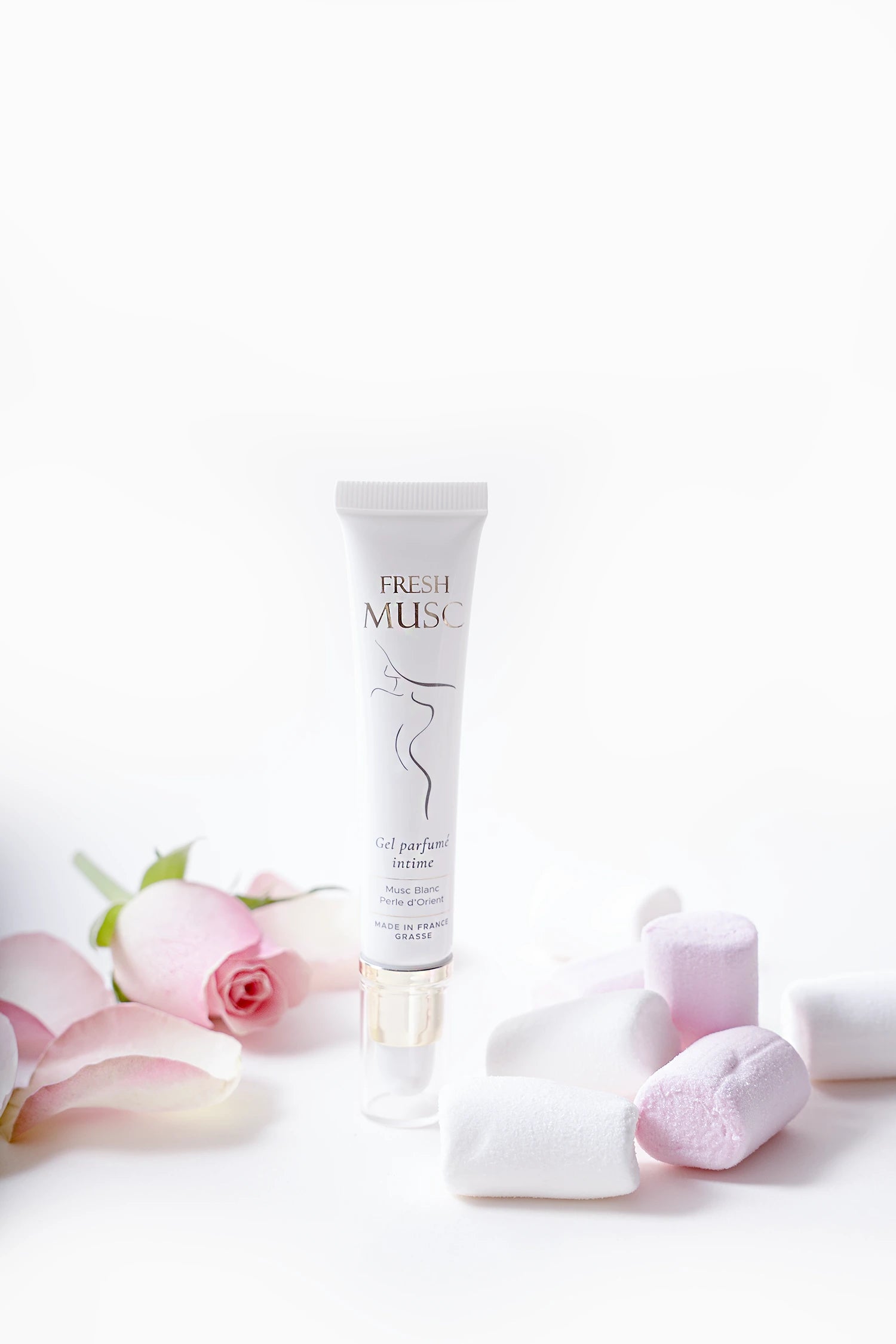Musk… A word that evokes a sensual scent , a unique musky substance that has survived the centuries to become one of the most prized ingredients in perfumery . But where does it actually come from? This captivating scent , now often synthetic or plant-based, originates from an abdominal gland of a small wild deer , the musk chevrotain , which lives in the Himalayan and Siberian mountains. However, behind this rich and warm scent lies a complex history, where the extraction of animal musk has long been marked by cruel practices. Fortunately, the perfume industry has found ethical and sustainable solutions . Alternatives such as white musk , tahara musk , or even synthetic products such as muscone have helped preserve this musky scent while respecting the environment. But how is such an intense and warm perfume made today, and why is musk still considered one of the most prized base notes ?
What is the origin of musk?
Musk is an aromatic substance highly prized for its intense and sensual musky odor , which makes it an essential ingredient in perfumery . Traditionally, musk comes from animal origin: it is secreted by the abdominal glands of a small wild deer , the musk deer , found mainly in the Himalayan and Siberian regions. These animals produce this odorous substance during their rutting season, and once extracted, it is dried and ground to obtain a musky powder with incomparable olfactory properties .
However, the extraction of animal musk has long involved cruel methods , such as the capture and killing of males, which led to the practice being banned in most countries, including Asia . This controversial history has led to the search for alternatives, including synthetic musk and plant musk , which reproduce the original musky notes while respecting biodiversity and ethics.
Today, alternatives such as white musk , tahara musk , or even perfumes based on synthetic musk , such as Perle d'Orient white musk eau de parfum , have made it possible to maintain the essence of musk while offering more sustainable and ethical solutions.

What is the history of musk?
The history of musk dates back to ancient times , where it was used both as a medicinal material and as a perfume in Eastern civilizations. In China , in the 4th century , it was considered a precious substance with aphrodisiac and medicinal properties, widely prized for its intense aroma and longevity . In the Middle Ages , the use of musk spread to the Near East and Europe , where it became a fundamental raw material in the creation of noble perfumes , often combined with substances such as ambergris or sandalwood .
During the 12th and 13th centuries , musk developed in Arab cultures, where more advanced extraction techniques and innovative olfactory associations were explored. Musk thus became an emblematic note of oriental perfumes , with warm , opulent and sensual aromas.
In the early 20th century, with the rise of ethical concerns about animal exploitation, the musk trade changed. Perfumers turned to alternatives like muscone , habanolide , and galaxolide , synthetic musk molecules that faithfully mimic the scent of natural musk while being environmentally friendly. It was also during this time that tahara musk was born, a modern, clean version of musk, particularly popular in intimate hygiene rituals .
What are the uses of musk?
Musk is above all an essential raw material in the creation of perfumes , where it is used mainly as a base note to fix other scents and prolong their trail . It plays a key role in the olfactory composition , offering incomparable sensuality and depth . It is this quality that makes musk an essential ingredient in products such as eaux de parfum and eaux de toilette , where it is combined with floral , woody or oriental aromas to create long-lasting fragrances .
Musk is also used in more specialized products, such as scented gels , like the Tahara Musk Scented Gel , which are prized for their softness and freshness . This musk, often of the synthetic or plant type, is favored for ethical reasons, being free from animal extraction.
Perfumers also appreciate the versatility of musk , which lends itself equally well to men's and women's fragrances , and even unisex fragrances , thanks to its ability to adapt to different olfactory families while fixing the other notes .

Where does natural musk come from?
Natural musk comes from a discreet and rare animal: the musk deer , sometimes called a chevrotin . This small Asian deer secretes a musky substance in an abdominal gland , mainly during the rutting season. This secretion, once extracted, dried and ground, once produced an extremely concentrated fragrant powder , with an incomparable olfactory content .
Musk extraction was often carried out under cruel conditions, involving the capture and killing of males. These old-fashioned methods are now banned almost everywhere in the world, including in Asia , for obvious reasons of species preservation and respect for animal welfare .
It is this animal origin that gives musk its ambivalent reputation : both a precious ingredient and a controversial substance . Nowadays, the majority of musky products such as Oriental Musk in scented gel are made from synthetic or plant-based musks, offering an ethical and sustainable solution .
White musk, tahara musk, solid musk: what are the differences?
White musk, tahara musk, and solid musk are modern variations of musk, suited to different preferences and needs.
White musk:
White musk is a sweet, clean note , widely used in modern perfumes . Unlike animal musk, it does not contain secretions from animals, but is made from synthetics that mimic the original musky scent . This musk is highly prized for its light and soothing substance , ideal for floral or woody fragrances. Tahara musk , in particular, is known for its musky freshness that recalls notes of cotton and cleanliness . This plant musk has a composition that evokes the scent of animal musk, but in a more ethical and sustainable way. It is particularly popular in products like Tahara Musc Fraîcheur Blanc et Coton .
Tahara musk:
Tahara musk is a variation of white musk, specifically formulated to provide an intimate and comforting fragrance, often used in intimate hygiene rituals . It is appreciated for its softness , freshness and lightness , while retaining the essence of the musky scent . Its organic and ethical composition makes it a choice alternative for those looking to combine sensuality and respect for the environment. It is available in gel form that can be applied to the skin for a lasting feeling of softness .
Solid musk:
Solid musk, on the other hand, is a concentrated and pure form of musk, often used in niche perfumes . Its solid texture allows for targeted application and a long-lasting scent, with a musky depth that develops throughout the day. This type of musk is often a stronger alternative , and it can be used as a base note in woody , oriental or musky compositions. This product is distinguished by its exceptional longevity and is highly valued for its fixative properties in perfumes.
Is there a plant musk?
Plant musk is an innovative and ethical alternative to traditional animal musk. This musk is extracted from various plants and seeds , and its composition mimics the musky scent while respecting the principles of sustainability and animal welfare . Unlike synthetic musk, which is produced in laboratories, plant musk comes from natural resources , thus offering a more ecological and biodiversity-friendly fragrance.
Origin of plant musk:
Plant musk can be extracted from seeds , roots or flowers that have aromatic properties similar to traditional musk. For example, certain plants such as civet , mimosa or coriander can produce musky compounds that are used to imitate the smell of animal musk in perfume compositions. This type of musk is increasingly popular with ethical perfumers , who seek to limit the environmental impact while preserving the olfactory richness of their creations. Plant musk and its use thus becomes a sustainable and ethical solution to meet the demands of environmentally conscious consumers.
Plant musk in beauty products:
Plant musk also finds its place in skin care and intimate hygiene products, thanks to its gentle and soothing properties. It is used in products where its freshness and fixing properties are highlighted. It fits perfectly into beauty rituals while providing a unique and pleasant fragrance, in complete safety for animals and the environment.
Synthetic musk: a revolution in perfumery
Synthetic musk was developed as a modern alternative to traditional musk, which is often of animal origin. Over time, it has taken a central place in contemporary perfumery, thanks to its ability to recreate the musky scent with molecules such as muscone , galaxolide , or macrocyclic musks . These compounds are produced in the laboratory to provide a musky note identical to that of natural musk, but in a more sustainable and less expensive way.
Benefits of Synthetic Musk:
Synthetic musk has many advantages over its natural counterpart. In addition to being a more ethical solution , it is also more stable and can be formulated to offer exceptional longevity and increased tenacity in perfumes . This type of musk is often used in eau de parfum , eau de toilette , or even in products like Fresh Musc intimate fragrances , which seek a lasting sensation of freshness without harming the environment.
The popularity of synthetic musk:
Synthetic musk has become essential in the creation of modern perfumes , as it allows perfumers to more easily control the composition and intensity of musky notes . For example, perfumes like Perle d'Orient White Musk Eau de Parfum use this synthetic musk to deliver a pure , soft , and long-lasting scent.

How is musk made today?
Musk production today relies primarily on two methods: chemical synthesis and the use of plant materials . These processes allow the musky scent to be recreated while respecting ethical and environmental standards. The method chosen depends on the type of musk (animal, plant, or synthetic) and the desired end product.
Chemical synthesis of musk:
Synthetic musk is primarily made using synthetic molecules that mimic the structure of natural musk . These molecules, such as galaxolide or musk ketone , are created in a laboratory and offer a depth of scent comparable to animal-derived musk, but without the negative impacts on animals. This process allows for more accessible fragrances while ensuring consistent quality . White musk or Tahara musk, for example, are made using this process to offer a soft, light musky note .
Vegetable musk:
Plant musk is produced from plants and seeds rich in natural musky compounds . This type of musk is softer and more subtle , offering floral or woody nuances. Aromatic plants such as mimosa or civet are often used for their natural musky scent . Plant musk is particularly sought after for its ability to offer an ethical and sustainable fragrance. An example of modern plant musk is the Tahara Musk Scented Gel, which combines the properties of freshness and purity .
Handcrafted manufacturing and innovation:
The production of musk, whether synthetic or plant-based, often involves carefully crafted processes, particularly in niche perfumeries . Some perfumers continue to explore older , more authentic techniques while incorporating modern innovations, ensuring a high-quality final product. Solid musk , for example, is a concentrated form of musk, prized for its longevity and intensity . It can be found in luxury beauty products or niche perfumes .
The role of musk in a perfume
Musk plays a crucial role in perfume creation as a base note . It has the ability to lock in the other notes of the fragrance, ensuring its longevity and intensity throughout the day. This is why musk is often used in combination with floral , woody , or oriental aromas to enhance its elegance and depth .
Perfume fixative:
Musk is a fixative par excellence in olfactory compositions. Thanks to its unique properties, it prolongs the hold of perfumes and allows the top and middle notes to flow harmoniously . Thus, in perfumes, musk acts as a stable base , allowing floral and woody fragrances to diffuse lastingly. This fixative property is essential for perfumes that must last throughout the day or evening.
Musk and olfactory notes:
Musk is often associated with floral and woody notes, bringing a sensual and warm dimension . For example, white musk blends wonderfully with white flowers like jasmine or rose , creating a balanced and refined fragrance . In other compositions, such as those of oriental perfumes, it blends with aromas of amber , vanilla , or even patchouli , for a deeply musky and exotic scent.
Why does musk still fascinate so much?
For centuries, musk has held a unique fascination for perfumers and consumers alike . Its ability to fix fragrances , provide a sensual and long-lasting base note , and evoke warm and intimate sensations makes it an irreplaceable ingredient in the art of perfumery. Moreover, thanks to the emergence of plant and synthetic musk, it is now possible to appreciate its olfactory benefits while respecting ethics and the environment. Whether you prefer tahara musk , white musk , or musky perfumes , there is a product for every taste and every season .






